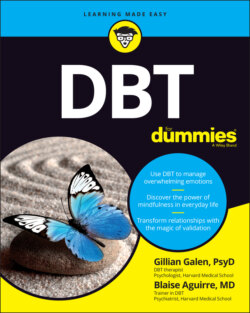Читать книгу DBT For Dummies - Gillian Galen - Страница 104
Using the concept of opposite action
ОглавлениеAnother useful approach is the practice of inducing a counteracting emotional state. The idea behind this is to counteract a maladaptive behavior caused by an intense emotion by inducing another emotion, one that triggers opposing or differing action urges or tendencies. For example, say that your best friend had promised to call you last night and she didn’t. You’re angry and all you want to do is rage at her and tell her what a terrible friend she is. If instead, you could conjure up the love you have for her and all the wonderful ways that she has been there for you in the past, you would be opposing hatred with love. This practice is consistent with the emotion regulation skill of opposite action in DBT.
Another way to think about this is that if an emotion has an action that follows, that means the emotion has caused the action. You can change the emotion by changing the action that follows. Here is the beauty of opposite action: Not only do emotions cause actions, but actions cause emotions, and so you can change your emotion by changing your action.
Opposite action works best when your emotions do not fit the facts of a current situation. If you’re afraid of a rattlesnake in your living room in Arizona, then the fear fits the facts and it’s justified if the snake is there. If the snake isn’t there, then the fear doesn’t fit the facts and is unjustified. If the emotion doesn’t fit the facts, this means that its intensity and duration aren’t effective in helping you achieve your long-term goals.
If you’re going to use opposite action, it’s important to throw yourself fully into the skill. Engage in behaviors that are opposite or different to the ones that you feel the urge to do, and then use opposite emotion words, thoughts, facial expressions, tone of voice, and body posture. For instance, consider these examples:
Fear: If you feel afraid, approach the situation or trigger that gives you anxiety. Try to face your fear. Engage in behaviors that increase your sense of control over your fear. You can repeatedly expose yourself to your unjustified fear in order to desensitize yourself. For instance, if you’re afraid of speaking to your boss, then you can repeatedly practice approaching her with confidence.
Anger: If you are angry at someone and feel like lashing out, you can instead initially avoid them rather than attack them, and then practice empathy for them and the behavior that made them do what they did. You can try to find the kernel of truth in their actions. Something caused their actions. Be curious about what it was.
Sadness: If you’re feeling low or depressed, rather than avoiding, isolating, or staying in bed, you can approach, engage, and get out of bed. You don’t isolate, but instead engage in activities that connect and keep you active and busy.
Shame: If you feel shame over something you have done and the shame is justified, then apologize. If the shame doesn’t fit the facts and is unjustified, then you need to engage fully in the situation that induced the shame by participating in social interactions, and even share your ideas and behaviors that led to the experience of shame.
Guilt: Similar to shame, if your guilt fits the facts, you need to apologize for the transgression. If your guilt is unjustified, then you must not apologize. Instead, change your body posture by walking tall with shoulders back and maintaining good eye contact while talking with a confident, steady, and clear voice.
